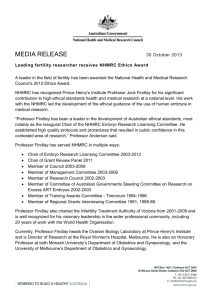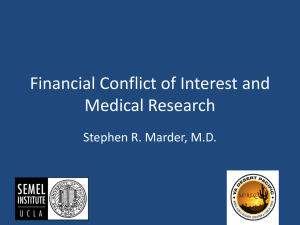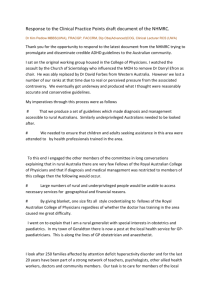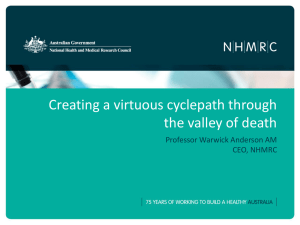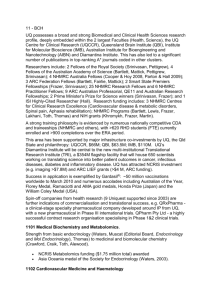Identifying and Managing Conflicts of Interest of Prospective
advertisement
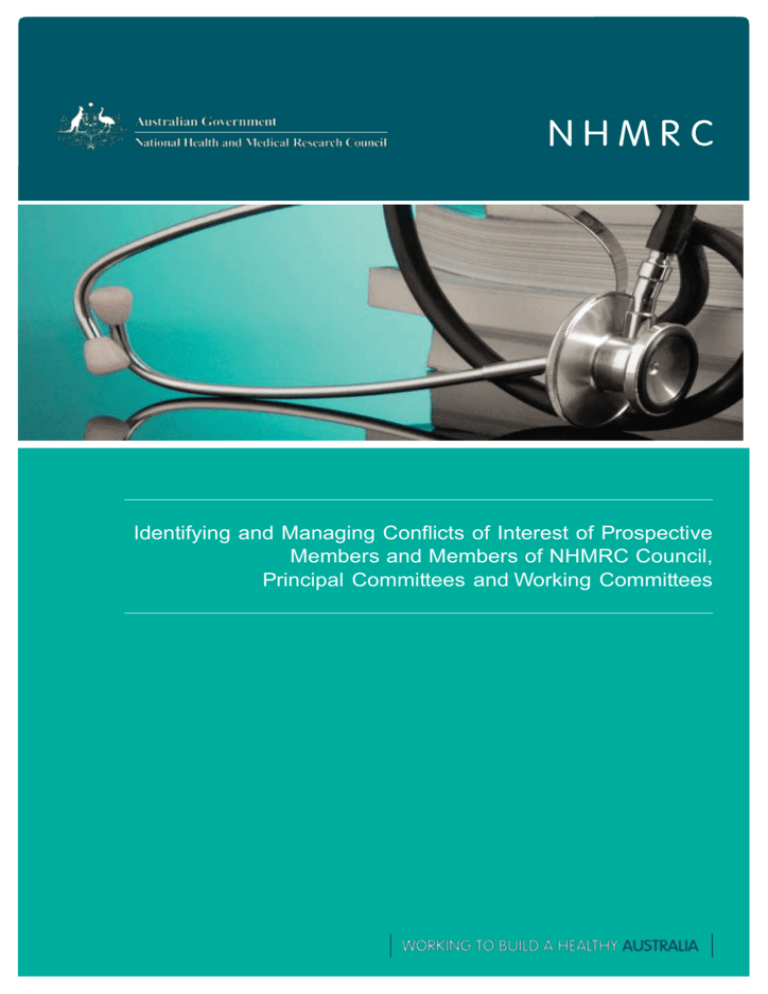
Identifying and Managing Conflicts of Interest of Prospective Members and Members of NHMRC Council, Principal Committees and Working Committees Identifying and Managing Conflicts of Interest of Prospective Members and Members of NHMRC Council, Principal Committees and Working Committees 1. Introduction 1.1 Members of NHMRC Committees1 provide high quality, expert and independent advice that enables NHMRC to discharge its functions. 1.2 Members are appointed for their expertise and experience across a diverse range of professions and fields. Appointments are also made with consideration given to balancing the benefit of having persons with expertise against the risks of their interests biasing a process. Depending on the issue, consideration by either the Chair or the CEO or their Delegate2 will have to be given as to whether or not members have real, perceived or potential conflicts between their responsibilities in activities involving NHMRC and their personal interests or other professional responsibilities. 1.3 These guidelines are designed to assist and inform members in the exercise of their responsibilities in order to ensure all conflicts of interest are addressed in a rigorous and transparent way that accords with the requirements of the National Health and Medical Research Council Act 1992 (the NHMRC Act 1992). 1.4 Prior to their appointment, members are required to complete and sign a NHMRC Form for Disclosure of Interests of Prospective Members of Council, Principal Committees and Working Committees (The Disclosure Form). 2. Scope 2.1 These guidelines apply to: • members of Council and its Principal Committees appointed by the Minister • members of NHMRC committees appointed by the CEO or their Delegate.3 2.2 These guidelines may not apply in the following circumstances: • For members of Guideline Development Committees refer to Guideline Development and Conflicts of Interest: Identifying and Managing Conflicts of Interest of Prospective Members and Members of NHMRC Committees and Working Groups Developing Guidelines. 1 2 3 For the purposes of this guideline the term ‘Committee’ will be used to refer to the NHMRC Council, Principal Committees and Working Committees. The CEO may delegate all or any of his or her powers or functions – see NHMRC Act 1992 82(1C). Exceptions to this are listed at 2.2. Identifying and Managing Conflicts of Interest National Health and Medical Research Council 2 • Situations where the CEO or their Delegate establishes a committee under subsection 39(1) of the NHMRC Act 1992 and decides that different measures are appropriate. In these cases, it is the responsibility of the CEO or their Delegate to determine the procedure to be followed by the committee and to include the disclosure of members’ interests in matters being considered by the committee (see Section 39(3)). 3. The Disclosure of Interests 3.1 The intent of this guidance on the disclosure of interests is to have the members of NHMRC Committees disclose any interests relevant to any of the issues that are under consideration in order that: a) such interests can be assessed and managed appropriately b) the maximum pertinent expertise can be retained c) each participant can form their own judgement about the issue on which they are offering advice, while being aware of the interests of other group members 4. Typical circumstances in which interests arise 4.1 Interests may involve but are not limited to: a) financial interests such as receipt by the prospective member or ‘immediate family members’ (partner and dependent children) of payments, gratuities, consultancies, honoraria, employment, grants, support for travel or accommodation, payment for meals and beverages or entertainment or educational event attendance (including registration fees) or gifts from an entity having a commercial interest in the issues being considered by the committee b) any other direct or pecuniary interest considered relevant (for instance, having provided expert testimony on behalf of an entity with a commercial or other interest in the issues being considered by the committee) c) relationships, including board membership, employment, stock ownership or consultancies between the prospective member or ‘immediate family members’ (partner and dependent children) and corporations whose products or services are related to the issues being considered by the committee or that have a commercial or other interest in the issues being considered by the committee d) affiliations to or associations with any organisations or activities which could reasonably be perceived to be an influence due to a competing interest either for or against the issues being considered by the committee e) institutional interests (that is, interests arising from an affiliation or association of an individual to an institution) – for example, when parties with an interest in the issues being considered by the committee have made gifts to the member’s institution to endow chairs or fund the construction of research facilities or donate equipment to support a project in which the member is involved; or when research conducted within an institution could affect the value of equity that the institution holds in a company or the value of a patent that the institution licenses to a company f) receipt of research funding by the prospective member or immediate family members from any entity that has a commercial interest in the issues being considered by the committee g) any other influences which might reasonably be considered likely to affect the expert judgement of the individual, or lead to the perception by others that the judgement of the individual is compromised. Identifying and Managing Conflicts of Interest National Health and Medical Research Council 3 4.2 The two general circumstances under which conflicts of interest may arise and must be declared are the following: a) Financial interests: an interest must be declared when benefits or losses either in money or in-kind have occurred or may occur at a level that might reasonably be perceived to affect a person’s judgement in relation to fair decisions about evidence and their participation in committee decision-making. b) Other relationships: an interest must be declared when a strong position or prejudice or familial connection or other relationship held by a person could reasonably, or be perceived to, affect a person’s judgement in relation to fair decisions about evidence and their participation in group decision-making including making an effort to arrive at a consensus. 5. Key Elements of the Process of Disclosing and Managing Interests 5.1 Disclosure of interests before appointment 5.1.1 Prospective members are to provide written statements of any interest the member/person may have in matters to be considered or activities undertaken by the relevant committee. 5.1.2 Prospective Members are required to complete the Disclosure Form. 5.1.3 Note: Under s16(3)(c) of the Research Involving Human Embryos Act 2002, before appointing a member to the Licensing Committee, the Minister must be satisfied on receipt of a written declaration by the member proposed to be appointed that the member proposed does not have a direct or indirect pecuniary interest in a body that undertakes the use of excess ART [Assisted Reproductive Technology] embryos, or human eggs, or creation or uses of other embryos, being an interest of a kind that could conflict with the proper performance of the member’s functions. 5.2 Disclosure of interests during appointment 5.2.1 In addition to the disclosure of interests both prior to and at the time of appointment, members are required, during their term on the committee, to declare any relevant interests to the Chair if they arise or become evident. Note: if the circumstances of a member of NHMRC Licensing Committee change such that a direct or indirect pecuniary interest exists where it didn’t previously exist, the member will be required to resign from the committee. 5.2.2 If the Chair declares an interest, the CEO or their Delegate will determine the actions needed to manage a conflict of interest. 5.3 Procedure at Meetings 5.3.1 Chairs of meetings must provide the opportunity for members to declare an interest in any activity of, or matters being considered by, the committees. This is to be a standing agenda item for all committee meetings. At the commencement of each meeting, the Chairperson will invite members to declare or discuss any relevant matter. 5.3.2 In all cases, the event of a member’s disclosure must be recorded in the minutes of the meeting or, if given outside the meeting, be recorded in the minutes of the next meeting after disclosure.4 4 NHMRC Act 1992 Sections 42(A)(7) and 42(A)(8). Identifying and Managing Conflicts of Interest National Health and Medical Research Council 4 5.3.3 The Chair (or, when appropriate, the CEO or their Delegate)5 must ensure that a record be kept of the actions taken to manage conflict of interest throughout the life of the committee. The record must include the updating of declarations of interest at each meeting and any actions taken (e.g. a member was asked to leave the meeting while a recommendation was made, or a member was present during discussions but did not take part). If no action was deemed necessary by the Chair, this must also be noted in the record of the meeting. 6. Managing a conflict of interest 6.1 An actual, potential or perceived conflict of interest can undermine the credibility of a project, process or decision, which may in turn damage the reputation of NHMRC. Thus, managing conflicts of interest in a transparent fashion is essential. The primary mechanism used to identify interests is disclosure. Management of conflicts of interest is a matter of judgement and is the responsibility of the committee Chair (or, if the Chair has a conflict of interest, the responsibility of the CEO or their Delegate). The terms of an agreed management strategy may include: • public disclosure of significant interests • exclusion from certain discussions or decisions (e.g. an individual may contribute their expertise to a discussion or be able to answer questions from other members but not vote on a final outcome or the crafting of a final recommendation) • divestment of financial interests • resignation from membership of entities whose interests could be affected by any recommendations. 7. Responsibilities of Chairpersons and of ONHMRC Secretariats 7.1 In accordance with Section 42A(6)(b) of the NHMRC Act 1992, the final decision of whether or not the member of a committee can participate, as new disclosures of interest arise, must be made by the Chair of the committee. 7.2 In order to ensure consistency in decision-making, the ONHMRC Secretariat must ensure that Chairs, as well as members, of committees receive advice and guidance on the principles contained in this document and on whether or not disclosures of interests may trigger the need for action to manage a conflict of interest throughout the life of a committee. 7.3 In summary, Chairpersons and Secretariats need to: • Ensure the Disclosure Form is completed. • Have a printout on hand or accessible for handy reference of current declared interests and agreed management strategies for relevant committee members. • Ensure conflict of interest is a standing item on every agenda. • Record all conflicts of interest declared during a meeting. • Record all conflicts of interest management strategy activities. 7.4 All disclosures are to be kept in safe custody by the committee Secretariat. 7.5 Note: The Disclosure Form may not be sufficient to satisfy the requirements of s16(3) of the Research Involving Human Embryos Act 2002, which requires the Minister to be given a written declaration by a proposed member that they do not have ‘a direct or indirect pecuniary interest in a body that undertakes uses of excess ART embryos, being an interest that could conflict with the proper performance of the member’s functions’. 5 NHMRC Act 1992 42A(4) to 42A(8). Identifying and Managing Conflicts of Interest National Health and Medical Research Council 5 8. Disclosure of Appointed Members’ Personal Information 8.1 The Privacy Act 1988 allows disclosure of personal information in a number of circumstances, including where the individual has been made aware that information of that kind is usually disclosed, or the person has consented to the disclosure. 8.2 As part of the appointment process members are advised – and are asked to acknowledge – that their names, official positions outside NHMRC, relevant expertise and interests will be included on NHMRC documentation, including the NHMRC web site.6 This is provided for in the Disclosure Form. 9. Legislative requirements and policy 9.1 These guidelines cannot cover all cases where a conflict of interest may occur. Members may find themselves in situations that are not clear-cut and where there is a genuine doubt as to whether an interest exists. Where there is doubt, members need to disclose their interest. 9.2 There are legislative requirements in the NHMRC Act 1992 for members to disclose interests in matters being considered (see Section 42A). 9.3 Section 44B(3)(b) requires the Minister or the CEO (whoever made the appointment) to terminate the appointment if the holder of the office fails, without reasonable excuse, to comply with an obligation to disclose an interest under Section 42A of the NHMRC Act 1992.7 6 7 Exceptions to this requirement about the publication of interests will be made by the CEO in appropriate circumstances. It is also the member’s responsibility to be familiar with this and other requirements relating to “Terminations of appointments” in the NHMRC Act 1992 (see Section 44B). Identifying and Managing Conflicts of Interest National Health and Medical Research Council 6
